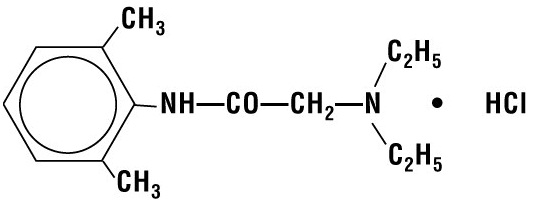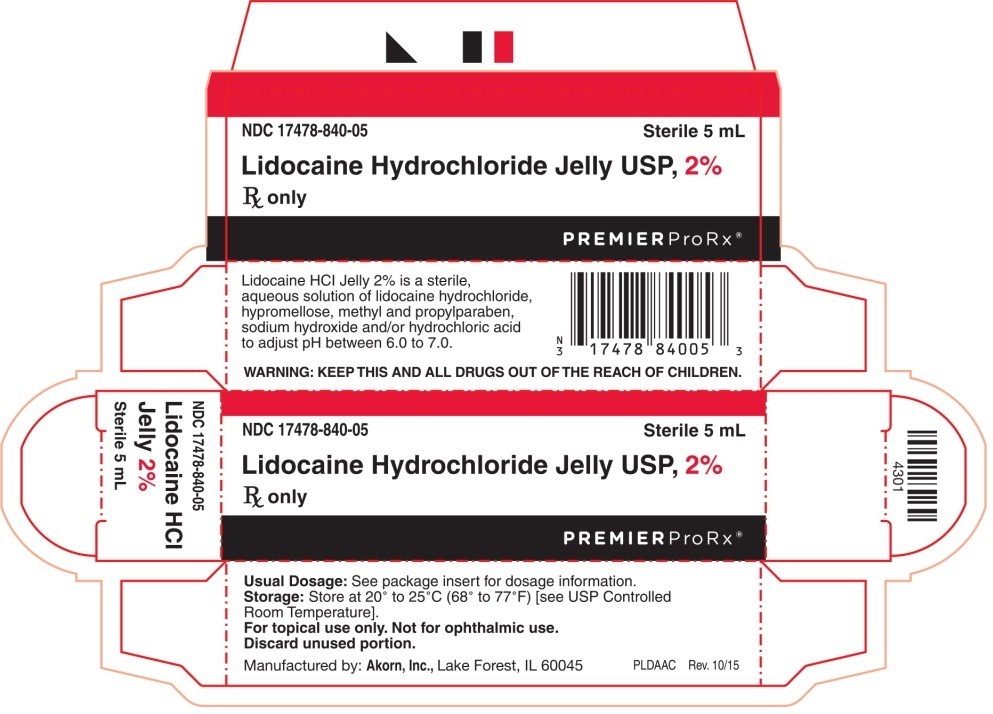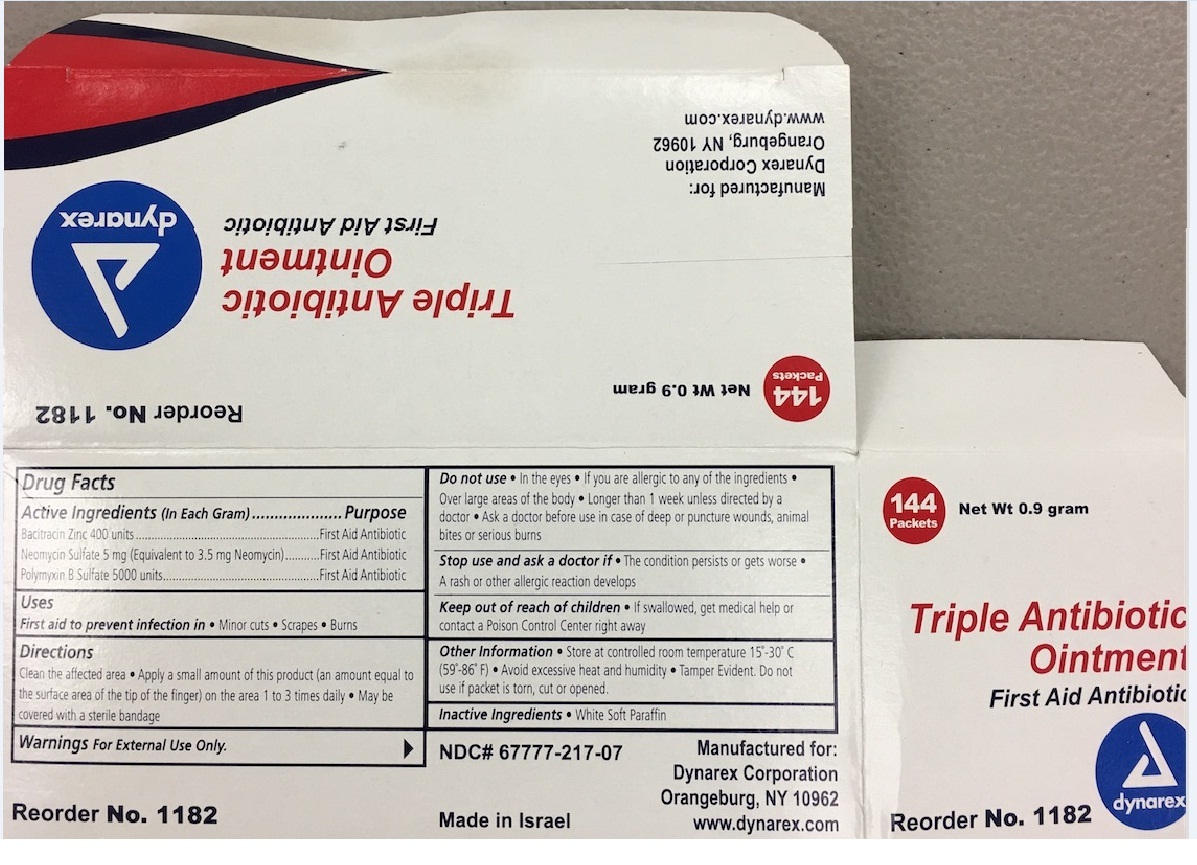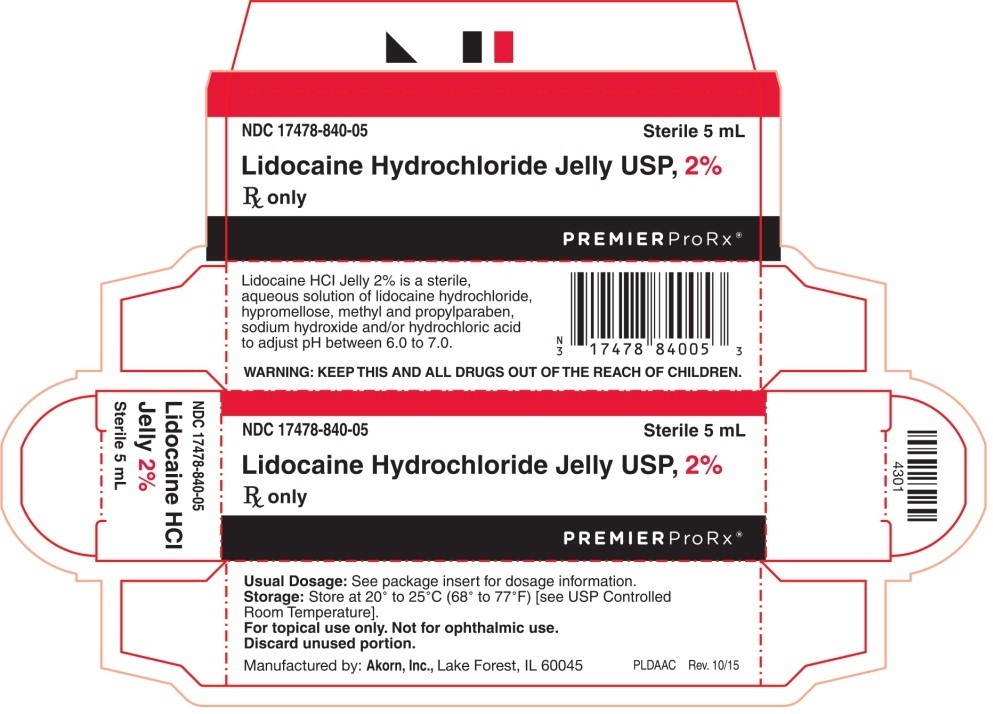Label: SX1 MEDICATED POST-OPERATIVE SYSTEM- lidocaine hydrochloride kit
-
Contains inactivated NDC Code(s)
NDC Code(s): 17478-840-05, 67777-217-07, 70529-941-01 - Packager: IT3 Medical LLC
- Category: HUMAN PRESCRIPTION DRUG LABEL
Drug Label Information
Updated February 25, 2022
If you are a healthcare professional or from the pharmaceutical industry please visit this version.
- Download DRUG LABEL INFO: PDF XML
- Official Label (Printer Friendly)
- SPL UNCLASSIFIED SECTION
-
DESCRIPTION
Lidocaine HCI 2% Jelly is a sterile, aqueous product that contains a local anesthetic agent and is administered topically. (See INDICATIONS for specific uses.)
Lidocaine HCI 2% Jelly contains lidocaine HCI which is chemically designated as acetamide, 2-(diethylamino)-N-(2,6-dimethylphenyl)-,monohydrochloride and has the following structural formula:

Its molecular formula is C14H22N2O • HCI and its molecular weight is 270.80.
Lidocaine HCI 2% Jelly also contains hypromellose, and the resulting mixture maximizes contact with mucosa and provides lubrication for instrumentation. The unused portion should be discarded after initial use.
Composition of Lidocaine HCI 2% Jelly 30 mL and 5 mL tubes: Each mL contains 20 mg of lidocaine HCI. The formulation also contains methylparaben, propylparaben, hypromellose, and sodium hydroxide and/or hydrochloric acid to adjust pH between 6.0 to 7.0.
-
CLINICAL PHARMACOLOGY
Mechanism of Action: Lidocaine stabilizes the neuronal membrane by inhibiting the ionic fluxes required for the initiation and conduction of impulses, thereby effecting local anesthetic action.
Pharmacokinetics and Metabolism: Lidocaine may be absorbed following topical administration to mucous membranes, its rate and extent of absorption depending upon concentration and total dose administered, the specific site of application, and duration of exposure. In general, the rate of absorption of local anesthetic agents following topical application occurs most rapidly after intratracheal administration. Lidocaine is also well-absorbed from the gastrointestinal tract, but little intact drug may appear in the circulation because of biotransformation in the liver.
Lidocaine is metabolized rapidly by the liver and metabolites and unchanged drug are excreted by the kidneys. Biotransformation includes oxidative N-dealkylation, ring hydroxylation, cleavage of the amide linkage, and conjugation. N-dealkylation, a major pathway of biotransformation, yields the metabolites monoethylglycinexylidide and glycinexylidide. The pharmacological/toxicological actions of these metabolites are similar to, but less potent than, those of lidocaine. Approximately 90% of lidocaine administered is excreted in the form of various metabolites, and less than 10% is excreted unchanged. The primary metabolite in urine is a conjugate of 4-hydroxy-2, 6-dimethylaniline.
The plasma binding of lidocaine is dependent on drug concentration, and the fraction bound decreases with increasing concentration. At concentrations of 1 to 4 mcg of free base per mL, 60 to 80 percent of lidocaine is protein bound. Binding is also dependent on the plasma concentration of the alpha-I-acid glycoprotein.
Lidocaine crosses the blood-brain and placental barriers, presumably by passive diffusion.
Studies of lidocaine metabolism following intravenous bolus injections have shown that the elimination half-life of this agent is typically 1.5 to 2.0 hours. Because of the rapid rate at which lidocaine is metabolized, any condition that effects liver function may alter lidocaine kinetics. The half-life may be prolonged twofold or more in patients with liver dysfunction. Renal dysfunction does not affect lidocaine kinetics but may increase the accumulation of metabolites.
Factors such as acidosis and the use of CNS stimulants and depressants affect the CNS levels of lidocaine required to produce overt systemic effects. Objective adverse manifestations become increasingly apparent with increasing venous plasma levels above 6 mcg free base per mL. In the rhesus monkey arterial blood levels of 18 to 21 mcg/mL have been shown to be threshold for convulsive activity.
- INDICATIONS AND USAGE
- CONTRAINDICATIONS
-
WARNINGS
EXCESSIVE DOSAGE, OR SHORT INTERVALS BETWEEN DOSES, CAN RESULT IN HIGH PLASMA LEVELS AND SERIOUS ADVERSE EFFECTS. PATIENTS SHOULD BE INSTRUCTED TO STRICTLY ADHERE TO THE RECOMMENDED DOSAGE AND ADMINISTRATION GUIDELINES AS SET FORTH IN THIS PACKAGE INSERT. THE MANAGEMENT OF SERIOUS ADVERSE REACTIONS MAY REQUIRE THE USE OF RESUSCITATIVE EQUIPMENT, OXYGEN AND OTHER RESUSCITATIVE DRUGS.
Lidocaine HCI 2% Jelly should be used in extreme caution in the presence of sepsis or severely traumatized mucosa in the area of application, since under such conditions there is the potential for rapid systemic absorption.
When used for endotracheal tube lubrication care should be taken to avoid introducing the product into the lumen of the tube. Do not use the jelly to lubricate the endotracheal stylettes. If allowed into the inner lumen, the jelly may dry on the inner surface leaving a residue which tends to clump with flexion, narrowing the lumen. There have been rare reports in which this residue has caused the lumen to occlude. (See also ADVERSE REACTIONS and DOSAGE AND ADMINISTRATION.)
-
PRECAUTIONS
General: The safety and effectiveness of lidocaine depend on proper dosage, correct technique, adequate precautions, and readiness for emergencies. (See WARNINGS and ADVERSE REACTIONS.) The lowest dosage that results in effective anesthesia should be used to avoid high plasma levels and serious adverse effects. Repeated doses of lidocaine may cause significant increases in blood levels with each repeated dose because of slow accumulation of the drug or its metabolites. Tolerance to elevated blood levels varies with the status of the patient. Debilitated, elderly patients, acutely ill patients, and children should be given reduced doses commensurate with their age and physical status. Lidocaine should also be used with caution in patients with severe shock or heart block.
Lidocaine HCI 2% Jelly should be used with caution in patients with known drug sensitivities. Patients allergic to para-aminobenzoic acid derivatives (procaine, tetracaine, benzocaine, etc.) have not shown cross sensitivity to lidocaine.
Many drugs used during the conduct of anesthesia are considered potential triggering agents for familial malignant hyperthermia. Since it is not known whether amide-type local anesthetics may trigger this reaction and since the need for supplemental general anesthesia cannot be predicted in advance, it is suggested that a standard protocol for management should be available. Early unexplained signs of tachycardia, tachypnea, labile blood pressure, and metabolic acidosis may precede temperature elevation. Successful outcome is dependent on early diagnosis, prompt discontinuance of the suspect triggering agent(s) and institution of treatment, including oxygen therapy, indicated supportive measures and dantrolene (consult dantrolene sodium intravenous package insert before using).
Information for Patients: When topical anesthetics are used in the mouth, the patient should be aware that the production of topical anesthesia may impair swallowing and thus enhance the danger of aspiration. For this reason, food should not be ingested for 60 minutes following use of local anesthetic preparations in the mouth or throat area. This is particularly important in children because of their frequency of eating.
Numbness of the tongue or buccal mucosa may enhance the danger of unintentional biting trauma. Food or chewing gum should not be taken while the mouth or throat area is anesthetized.
Carcinogenesis – Long-term studies in animals have not been performed to evaluate the carcinogenic potential of lidocaine.
Mutagenesis – The mutagenic potential of lidocaine has been tested in the Ames Salmonella reverse mutation assay, and in vitro chromosome aberrations assay in human lymphocytes and in an in vivo mouse micronucleus assay. There was no indication of any mutagenic effect in these studies.
Impairment of Fertility – The effect of lidocaine on fertility was examined in the rat model. Administration of 30 mg/kg, s.c. (180 mg/m2) to the mating pair did not produce alterations in fertility or general reproductive performance of rats. There are no studies that examine the effect of lidocaine on sperm parameters. There was no evidence of altered fertility.
Use in Pregnancy:
Teratogenic Effects: Pregnancy Category B.
Reproduction studies for lidocaine have been performed in both rats and rabbits. There was no evidence of harm to the fetus at subcutaneous doses of up to 50 mg/kg lidocaine (300 mg/m2 on a body surface area basis) in the rat model. In the rabbit model, there was no evidence of harm to the fetus at a dose of 5 mg/kg, s.c. (60 mg/m2 on a body surface area basis). Treatment of rabbits with 25 mg/kg (300 mg/m2) produced evidence of maternal toxicity and evidence of delayed fetal development, including a non-significant decrease in fetal weight (7%) and an increase in minor skeletal anomalies (skull and sternebral defect, reduced ossification of the phalanges). The effect of lidocaine on post-natal development was examined in rats by treating pregnant female rats daily subcutaneously at doses of 2, 10, and 50 mg/kg (12, 60, and 300 mg/m2) from day 15 of pregnancy and up to 20 days post partum. No signs of adverse effects were seen either in dams or in the pups up to and including the dose of 10 mg/kg (60 mg/m2); however, the number of surviving pups was reduced at 50 mg/kg (300 mg/m2), both at birth and the duration of lactation period, the effect most likely being secondary to maternal toxicity. No other effects on litter size, litter weight, abnormalities in the pups and physical developments of the pups were seen in this study.
A second study examined the effects of lidocaine on post-natal development in the rat that included assessment of the pups from weaning to sexual maturity. Rats were treated for 8 months with 10 or 30 mg/kg, s.c. lidocaine (60 mg/m2 and 180 mg/m2 on a body surface area basis, respectively). This time period encompassed 3 mating periods. There was no evidence of altered post-natal development in any offspring; however, both doses of lidocaine significantly reduced the average number of pups per litter surviving until weaning of offspring from the first 2 mating period.
There are, however, no adequate and well-controlled studies in pregnant women. Because animal reproduction studies are not always predictive of human response, this drug should be used during pregnancy only if clearly needed.
Labor and Delivery: Lidocaine is not contraindicated in labor and delivery. Should Lidocaine HCl 2% Jelly be used concomitantly with other products containing lidocaine, the total dose contributed by all formulations must be kept in mind.
Nursing Mothers: Lidocaine is secreted in human milk. The clinical significance of this observation is unknown. Caution should be exercised when lidocaine is administered to a nursing woman.
Pediatric Use: Although, the safety and effectiveness of Lidocaine 2% Jelly in pediatric patients have not been established, a study of 19 premature neonates (gestational age <33 weeks) found no correlation between the plasma concentration of lidocaine or monoethylglycinexylidide and infant body weight when moderate amounts of lidocaine (i.e. 0.3 mL/kg of lidocaine gel 20 mg/mL) were used for lubricating both intranasal and endotracheal tubes. No neonate had plasma levels of lidocaine above 750 mcg/L. Dosages in children should be reduced, commensurate with age, body weight, and physical condition. (See DOSAGE AND ADMINISTRATION.)
-
ADVERSE REACTIONS
Adverse experiences following the administration of lidocaine are similar in nature to those observed in other amide local anesthetic agents. These adverse experiences are, in general, dose-related and may result from high plasma levels caused by excessive dosage or rapid absorption, or may result from a hypersensitivity, idiosyncrasy, or diminished tolerance on the part of the patient. Serious adverse experiences are generally systemic in nature. The following types are those most commonly reported:
There have been rare reports of endotracheal tube occlusion associated with the presence of dried jelly residue in the inner lumen of the tube. (See also WARNINGS and DOSAGE AND ADMINISTRATION.)
Central Nervous System: CNS manifestations are excitatory and/or depressant and may be characterized by light headedness, nervousness, apprehension, euphoria, confusion, dizziness, drowsiness, tinnitus, blurred or double vision, vomiting, sensations of heat, cold or numbness, twitching, tremors, convulsions, unconsciousness, respiratory depression, and arrest. The excitatory manifestations may be very brief or may not occur at all, in which case the first manifestation of toxicity may be drowsiness merging into unconsciousness and respiratory arrest.
Drowsiness following the administration of lidocaine is usually an early sign of a high blood level of the drug and may occur as a consequence of rapid absorption.
Cardiovascular System: Cardiovascular manifestations are usually depressant and are characterized by bradycardia, hypotension, and cardiovascular collapse which may lead to cardiac arrest.
Allergic: Allergic reactions are characterized by cutaneous lesions, urticaria, edema, or anaphylactoid reactions. Allergic reactions may occur as a result of sensitivity either to the local anesthetic agent or other components in the formulation. Allergic reactions as a result of sensitivity to lidocaine are extremely rare and, if they occur, should be managed by conventional means. The detection of sensitivity by skin testing is of doubtful value.
-
OVERDOSAGE
Acute emergencies from local anesthetics are generally related to high plasma levels encountered during therapeutic use of local anesthetics. (See ADVERSE REACTIONS, WARNINGS, and PRECAUTIONS.)
Management of Local Anesthetic Emergencies: The first consideration is prevention, best accomplished by careful and constant monitoring of cardiovascular and respiratory vital signs and the patient's state of consciousness after each local anesthetic administration. At the first sign of change, oxygen should be administered.
The first step in the management of convulsions consists of immediate attention to the maintenance of a patent airway and assisted or controlled ventilation with oxygen and a delivery system capable of permitting immediate positive airway pressure by mask. Immediately after the institution of these ventilatory measures, the adequacy of the circulation should be evaluated, keeping in mind that drugs used to treat convulsions sometimes depress the circulation when administered intravenously. Should convulsions persist despite adequate respiratory support, and if the status of the circulation permits, small increments of an ultra-short acting barbiturate (such as thiopental or thiamylal) or a benzodiazepine (such as diazepam) may be administered intravenously. The clinician should be familiar, prior to use of local anesthetics, with these anticonvulsant drugs. Supportive treatment of circulatory depression may require administration of intravenous fluids and, when appropriate, a vasopressor as directed by the clinical situation (e.g., ephedrine).
If not treated immediately, both convulsions and cardiovascular depression can result in hypoxia, acidosis, bradycardia, arrhythmias, and cardiac arrest. If cardiac arrest should occur, standard cardiopulmonary resuscitative measures should be instituted.
Dialysis is of negligible value in the treatment of acute overdosage with lidocaine.
The oral LD50 of lidocaine HCI in non-fasted female rats is 459 (346 to 773) mg/kg (as the salt) and 214 (159 to 324) mg/kg (as the salt) in fasted female rats.
-
DOSAGE AND ADMINISTRATION
When Lidocaine HCI 2% Jelly is used concomitantly with other products containing lidocaine, the total dose contributed by all formulations must be kept in mind.
The dosage varies and depends upon the area to be anesthetized, vascularity of the tissues, individual tolerance, and the technique of anesthesia. The lowest dosage needed to provide effective anesthesia should be administered. Dosages should be reduced for children and for elderly and debilitated patients. Although the incidence of adverse effects with Lidocaine HCI 2% Jelly is quite low, caution should be exercised, particularly when employing large amounts, since the incidence of adverse effects is directly proportional to the total dose of local anesthetic agent administered.
For Surface Anesthesia of the Male Adult Urethra: When using Lidocaine 2% Jelly 30 mL tubes, sterilize the plastic cone for 5 minutes in boiling water, cool, and attach to the tube. The cone may be gas sterilized or cold sterilized, as preferred. Slowly instill approximately 15 mL (300 mg of lidocaine HCI) into the urethra or until the patient has a feeling of tension. A penile clamp is then applied for several minutes at the corona. An additional dose of not more than 15 mL (300 mg) can be instilled for adequate anesthesia.
Prior to sounding or cystoscopy, a penile clamp should be applied for 5 to 10 minutes to obtain adequate anesthesia. A total dose of 30 mL (600 mg) is usually required to fill and dilate the male urethra.
Prior to catheterization, smaller volumes of 5 to 10 mL (100 to 200 mg) are usually adequate for lubrication.
For Surface Anesthesia of the Female Adult Urethra: When using Lidocaine 2% Jelly 30 mL tubes, sterilize the plastic cone for 5 minutes in boiling water, cool, and attach to the tube. The cone may be gas sterilized or cold sterilized, as preferred. Slowly instill 3 to 5 mL (60 to 100 mg of lidocaine HCI) of the jelly into the urethra. If desired, some jelly may be deposited on a cotton swab and introduced into the urethra. In order to obtain adequate anesthesia, several minutes should be allowed prior to performing urological procedures.
Lubrication for Endotracheal Intubation: Apply a moderate amount of jelly to the external surface of the endotracheal tube shortly before use. Care should be taken to avoid introducing the product into the lumen of the tube. Do not use the jelly to lubricate endotracheal stylettes. See WARNINGS and ADVERSE REACTIONS concerning rare reports of inner lumen occlusion. It is also recommended that use of endotracheal tubes with dried jelly on the external surface be avoided for lack of lubricating effect.
-
MAXIMUM DOSAGE
No more than 600 mg of lidocaine HCI should be given in any 12 hour period.
Children: It is difficult to recommend a maximum dosage of any drug for children since this varies as a function of age and weight. For children less than ten years who have a normal lean body mass and a normal lean body development, the maximum dose may be determined by the application of one of the standard pediatric drug formulas (e.g., Clark's rule). For example, in a child of five years weighing 50 lbs., the dose of lidocaine hydrochloride should not exceed 75 to 100 mg when calculated according to Clark's rule. In any case, the maximum amount of Lidocaine HCI administered should not exceed 4.5 mg/kg (2 mg/lb) of body weight.
-
HOW SUPPLIED
Lidocaine HCI 2% Jelly is supplied in the listed dosage forms.
NDC 17478-840-30 30 mL aluminum tube
NDC 17478-840-05 5 mL aluminum tubeA detachable applicator cone and a key for expressing the contents are included in the 30 mL carton.
Storage: Store at 20° to 25°C (68° to 77°F). Excursions permitted to 15-30°C (59-86°F). See USP Controlled Room Temperature.
PREMIERProRx®
Manufactured by:
Akorn, Inc.
Lake Forest, IL 60045PremierProRx® is a registered trademark of Premier Inc., used under license.
PLD00N Rev. 10/15Assembled and Distributed by IT3 Medical, LLC
4447 N Central Expy; Ste 110-106
Dallas, TX 75205For questions or comments:
info@IT3-Medical.com
www.IT3-Medical.com - Drug Facts
- ACTIVE INGREDIENT
- Ask a doctor before use:
- Purpose
- Other information
- Inactive ingredients:
- Keep Out Of Reach Of Children
- Warnings
- Dosage and Administration
- Do Not Use:
- Stop use and ask a doctor if
- Sx1 Medicated Post-Operative System
- Packaging-System Label
- Packaging-System Components Labeling
-
INGREDIENTS AND APPEARANCE
SX1 MEDICATED POST-OPERATIVE SYSTEM
lidocaine hydrochloride kitProduct Information Product Type HUMAN PRESCRIPTION DRUG Item Code (Source) NDC:70529-941 Packaging # Item Code Package Description Marketing Start Date Marketing End Date 1 NDC:70529-941-01 1 in 1 PACKAGE; Type 9: Other Type of Part 3 Combination Product (e.g., Drug/Device/Biological Product) 05/01/2016 Quantity of Parts Part # Package Quantity Total Product Quantity Part 1 1 TUBE 5 mL Part 2 1 PACKET 0.9 g Part 1 of 2 LIDOCAINE
lidocaine hydrochloride jellyProduct Information Item Code (Source) NDC:17478-840 Route of Administration TOPICAL Active Ingredient/Active Moiety Ingredient Name Basis of Strength Strength LIDOCAINE HYDROCHLORIDE (UNII: V13007Z41A) (LIDOCAINE - UNII:98PI200987) LIDOCAINE HYDROCHLORIDE ANHYDROUS 20 mg in 1 mL Inactive Ingredients Ingredient Name Strength HYPROMELLOSE, UNSPECIFIED (UNII: 3NXW29V3WO) METHYLPARABEN (UNII: A2I8C7HI9T) PROPYLPARABEN (UNII: Z8IX2SC1OH) SODIUM HYDROXIDE (UNII: 55X04QC32I) HYDROCHLORIC ACID (UNII: QTT17582CB) Packaging # Item Code Package Description Marketing Start Date Marketing End Date 1 NDC:17478-840-05 1 in 1 CARTON 1 5 mL in 1 TUBE; Type 0: Not a Combination Product Marketing Information Marketing Category Application Number or Monograph Citation Marketing Start Date Marketing End Date ANDA ANDA040433 08/01/2013 Part 2 of 2 BACITRACIN ZINC, NEOMYCIN SULFATE AND POLYMYXIN B SULFATE
bacitracin zinc, neomycin sulfate and polymyxin b sulfate ointmentProduct Information Item Code (Source) NDC:67777-217 Route of Administration TOPICAL Active Ingredient/Active Moiety Ingredient Name Basis of Strength Strength BACITRACIN ZINC (UNII: 89Y4M234ES) (BACITRACIN - UNII:58H6RWO52I) BACITRACIN 400 [iU] in 1 g NEOMYCIN SULFATE (UNII: 057Y626693) (NEOMYCIN - UNII:I16QD7X297) NEOMYCIN 5 mg in 1 g POLYMYXIN B SULFATE (UNII: 19371312D4) (POLYMYXIN B - UNII:J2VZ07J96K) POLYMYXIN B 5000 [iU] in 1 g Inactive Ingredients Ingredient Name Strength PETROLATUM (UNII: 4T6H12BN9U) Packaging # Item Code Package Description Marketing Start Date Marketing End Date 1 NDC:67777-217-07 0.9 g in 1 PACKET; Type 0: Not a Combination Product Marketing Information Marketing Category Application Number or Monograph Citation Marketing Start Date Marketing End Date OTC monograph final part333B 12/01/2009 Marketing Information Marketing Category Application Number or Monograph Citation Marketing Start Date Marketing End Date ANDA ANDA040433 05/01/2016 Labeler - IT3 Medical LLC (079971231)






